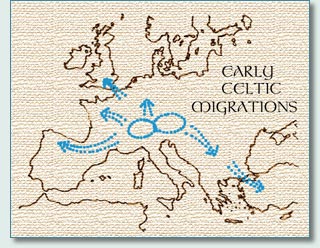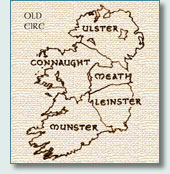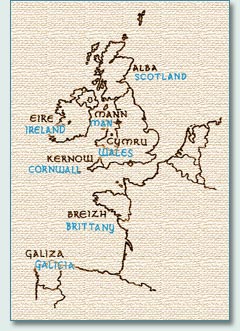CELTIC HISTORY
 Celtic people were at one time all over Europe, from the British Isles in the
west, to even as far as what is now Turkey in the East, living in tribes or clans
with their own chief or king. The ancient Greeks coined the name ' Keltoi' to
refer to, as they saw them, their mysterious neighbours. It meant "hidden/secretive
people".
Celtic people were at one time all over Europe, from the British Isles in the
west, to even as far as what is now Turkey in the East, living in tribes or clans
with their own chief or king. The ancient Greeks coined the name ' Keltoi' to
refer to, as they saw them, their mysterious neighbours. It meant "hidden/secretive
people".
The Celts have been around since at least 700 B.C. in Central Europe, the earliest recorded settlements being at Halstatt in what is now Austria, which was an important salt-mining area - salt in those days was nearly as valuable as gold! The expansion of the Celtic heartland was possibly due to their wealth from salt, and certainly due to their expertise as horsemen. Another early heartland in the 5th century B.C. centred around the La Tene settlement on Lake Neuchatel in what is now Switzerland. During the 5th to 3rd centuries B.C. they expanded south towards Italy, west to Gaul and Iberia, and east into Hungary, Greece and Turkey. In 387 B.C they sacked Rome, and 98 years later plundered the sanctuary of Delphi in Greece.
As the Roman Empire increased, Celtic regions were absorbed into it until the massive new territory covered most of Europe. Continental Celtic tribes migrated to the isles of the Britons to join the residents of those relatively safe havens, who may have been there as pre-celtic tribes since 2000 B.C. There were at least thirty named tirbes in ancient Briton. These extreme western islands, on the edge of the wild Atlantic Ocean, remained untouched for years, with very little outside influence, until 43 A.D., the Roman invasion. Their occupation covered most of what is now called England, at that time the home of many different Celtic tribes, the ancient Britons. The Romans occupied very little of Cornwall and Wales, never conquered Ireland, and even built 2 walls right across the north of the land to keep the Picts (of what is now Scotland) out of their new territory!
The ferocity of the ancient Celtic warriors of these areas was legendary through the centuries, and a whole legion of the Roman army never returned from the Pictish lands. The Picts lived in what is now Scotland. They were given the name 'Pictii' by the Romans, which meant 'painted people' - they were heavily tattooed, dyed and spiked their hair with lime, and preferred to fight almost naked to enable them to move quicker in battle. The name they used for themselves was the "Cruithne". The only legacy of these mysterious people are their symbol-carved stones, which stand all over Scotland, especially in the north-east.
History and myth are mingled in early Celtic times. Ancient Irish history is relevant to all the Celtic Lands, and shaped the peopling of the surrounding islands. Archaic Irish manuscripts, the 'Book of Invasions' say that 5 groups of invaders arrived before the Celtic Gaels. The Cessair, led by Noah's grand-daughter of that name, arrived 40 days before the Great Flood after sailing for 7 years. The Partholons arrived next, and battled the Fomorian warlike residents, winning possession of the island for 300 years, until destroyed by plague. Next were the Nemedians (possibly of Greek or Scythian origin), who beat the Fomorians several times, but were decimated by plague, and were finally were defeated by their foes. Among those that escaped was a Nemedian warrior, Briotan said to have given his name to the island and people of Briton.
 Descended
from the Nemedians were the next wave, the Fir Bolg, who divided the old land
into 5 provinces, Leinster, Meath, Connaught, Ulster and Munster. Meath later
merged with Leinster. The following invasion was by a mystical race known as the
Tuatha de Danann (the children of Danann), said to have arrived from the sky.
They were a beautiful, artistic warrior race, descended from the Nemedians, and
achieved god-like status in Irish mythology. They defeated the Fir Bolg at the
First Battle of Moy Tura, only to return there later to fight the ancient enemy,
the Fomorians, at the Second Battle of Moy Tura, led by King Nuada of the Silver
Arm and their warrior hero Lugh the Il-Dana. Nauda was slain, and so was the Fomorian
king, Balor of the Evil Eye, by his own grandson, Lugh, forever ending Fomorian
power.
Descended
from the Nemedians were the next wave, the Fir Bolg, who divided the old land
into 5 provinces, Leinster, Meath, Connaught, Ulster and Munster. Meath later
merged with Leinster. The following invasion was by a mystical race known as the
Tuatha de Danann (the children of Danann), said to have arrived from the sky.
They were a beautiful, artistic warrior race, descended from the Nemedians, and
achieved god-like status in Irish mythology. They defeated the Fir Bolg at the
First Battle of Moy Tura, only to return there later to fight the ancient enemy,
the Fomorians, at the Second Battle of Moy Tura, led by King Nuada of the Silver
Arm and their warrior hero Lugh the Il-Dana. Nauda was slain, and so was the Fomorian
king, Balor of the Evil Eye, by his own grandson, Lugh, forever ending Fomorian
power.
 The
Tuatha de Danann ruled Ireland for 197 years, their main residences being in the
Boyne Valley, where the ancient megalithic tombs of Newgrange, Knowth and Dowth
stand. The next invasion was by the Milesians, of whom the descendants were the
Gaelic Irish. These people are said to have come from Galiza, on the Atlantic
corner of what is now north-west Spain. Mile, the founder of that race, was married
to Scota ( who may have given her name to the later Irish settlers of Scotland),
and their son Breagon and his sons, are said to have sailed to Ireland from there.
Although they beat the Tuatha in battle and settled, mysterious blights on their
land and animals forced them to allow the Tuatha de Danann to remain in Ireland,
however this magical race retreated to their 'sidh' or 'fairy mounds', and other
special natural places in the landscape, where they are still said to live today.
The
Tuatha de Danann ruled Ireland for 197 years, their main residences being in the
Boyne Valley, where the ancient megalithic tombs of Newgrange, Knowth and Dowth
stand. The next invasion was by the Milesians, of whom the descendants were the
Gaelic Irish. These people are said to have come from Galiza, on the Atlantic
corner of what is now north-west Spain. Mile, the founder of that race, was married
to Scota ( who may have given her name to the later Irish settlers of Scotland),
and their son Breagon and his sons, are said to have sailed to Ireland from there.
Although they beat the Tuatha in battle and settled, mysterious blights on their
land and animals forced them to allow the Tuatha de Danann to remain in Ireland,
however this magical race retreated to their 'sidh' or 'fairy mounds', and other
special natural places in the landscape, where they are still said to live today.
Many years later the Gaelic Scots arrived from the north-east coast of Ireland and settled in the south-west of Pictland(now Scotland), establishing a power base at Dunadd. For the next 800 years they expanded their territory north and east, alternately warring, mixing, and intermarrying with the Picts until until 844, when the 2 races were united under one king.
The withdrawal of the Roman army back to their dying empire on the continent, left the British lands open to new invaders. These Romano-Britons had lived in relative peace for centuries, and employed mercenary warriors from Europe to help them against invaders. But seeing these lands, a lot of those mercenaries returned home, only to gather forces and return to stay. The Saxons and Angles were the next big threat. Central Britain fell to these Germanic invaders, and over the centuries became England, with a new language brought from the continent, the ancestor of what we speak today. The Celtic Lands had their own languages, far older than English, as we shall see later.
 The northern and western lands held out against the Saxons, and defined
the areas we think of as Celtic today, Scotland, Ireland, Wales, the Isle of Man,
Cornwall and Brittany (the latter Celtic nation, Brittany, on the continent, was
settled from Cornwall). The name 'Cornwall' actually derives from the Saxon word
'Cornwalas' meaning something like 'land of strange/dark foreigners', which indicates
that the Cornish Celts had maintained their own identity well apart from the Romans
and Saxons. An often overlooked Celtic area of Europe still exists in Galicia,
in north-west Spain.
The northern and western lands held out against the Saxons, and defined
the areas we think of as Celtic today, Scotland, Ireland, Wales, the Isle of Man,
Cornwall and Brittany (the latter Celtic nation, Brittany, on the continent, was
settled from Cornwall). The name 'Cornwall' actually derives from the Saxon word
'Cornwalas' meaning something like 'land of strange/dark foreigners', which indicates
that the Cornish Celts had maintained their own identity well apart from the Romans
and Saxons. An often overlooked Celtic area of Europe still exists in Galicia,
in north-west Spain.
The Saxons legendary opponent was Arthur, King of the Britons, who was probably a very powerful Celtic king, who for the first time, united the local Celtic kingdoms to withstand the Saxon invasion. There is much speculation as to the origins of Arthur, and even his existence, but most evidence points to him being at large during the 5th century, ranging from Wales to Cornwall, even Brittany and as far north as Scotland.
The next invading menace were the Danish Vikings. They raided the northern lands for years, settling in the islands north and west of Scotland, the Shetland Islands, the Orkneys, and the Hebrides, and some Scottish clans are descended from the Vikings. All those islands remained for years a separate nation, the Kingdom of The Isles, ruled by various Lords of the Isles, who maintained their independence and refused to recognise mainland Scottish rule, even as late as the 1600-1700s. The Vikings also invaded and had settlements in Ireland, including Dublin and several other towns. The high Round Towers that can be seen at ancient monasteries all over Ireland were built as refuges against raiding Vikings.
The Normans from France, originally 'Northmen' or Vikings themselves, invaded Britain in 1066 - this affected the Celtic lands more than any other previous invasion. They occupied the Anglo-Saxon areas, and the Celtic lands of Cornwall, Wales, and Scotland, and later invaded Ireland. All the massive stone castles still standing today in all the above areas , were built by the Normans or their descendants. From then on, each Celtic Nation has a complicated and specific history, detailed in another section.